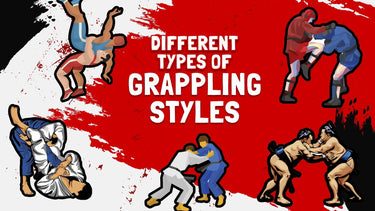
Introduction
In the world of combat sports, grappling is a cornerstone, uniting centuries-old traditions with modern innovations. From the philosophy of Judo to the art of Brazilian Jiu Jitsu (BJJ), and the power of wrestling, this article explores the rich tapestry of grappling. It emphasizes the significance of grappling in combat sports and takes you through the historical journey of various grappling styles. Grappling martial arts focus on techniques such as throws, takedowns, joint locks, and submissions. These styles emphasize controlling an opponent through leverage and technique rather than strikes.

Introduction to Judo as a Grappling Martial Art
Judo, often referred to as "The Gentle Way," may sound paradoxical to the uninitiated. Born in Japan in the late 19th century, this martial art embodies the concept of using an opponent's force against them. Judo's philosophy centers around yielding, balance, and precise technique rather than brute strength. It's a martial art that has influenced numerous other grappling styles.
Key Techniques and Principles in Judo
In Judo, practitioners learn a range of throws, pins, joint locks, and strangleholds. These techniques are executed with impeccable timing and leverage. A well-executed throw in Judo can be a thing of beauty. The sport also emphasizes the importance of grip fighting and achieving control over your opponent. Understanding the principle of "Seiryoku Zenyo" or "maximum efficiency" ensures one expends the least amount of effort for the greatest effect.
Judo's Influence Beyond the Dojo
Judo's influence extends beyond the dojo, with principles incorporated into other grappling styles like BJJ. This cross-pollination emphasizes the importance of wearing the right attire, such as a durable Gi, and for those who wish to experiment, even a rash guard can provide comfort and protection during practice.

Brazilian Jiu Jitsu (BJJ): The Art of Submission
Focus on Ground Fighting
Brazilian Jiu-Jitsu, commonly known as BJJ, is the art of submission—a ground-based martial art that empowers practitioners to control and submit their opponent through a variety of joint locks and strangleholds. BJJ emphasizes adaptability, strategy, and patience.
Influence on MMA
The impact of BJJ on Mixed Martial Arts (MMA) cannot be overstated. Its focus on ground fighting and submission techniques has revolutionized combat sports. Many MMA fighters now have a strong BJJ foundation, providing a significant advantage when fights hit the ground.
BJJ Attire and Training Variations
BJJ practitioners wear rash guards, shorts, and spats for durability and flexibility. Training comes in two variations: Gi and No-Gi. Gi training involves a traditional uniform providing extra grip and control. No-Gi emphasizes speed and friction-based techniques.

Wrestling: A Foundation of Grappling
Various Styles (Freestyle, Folkstyle, Greco-Roman)
Wrestling encompasses multiple styles: Freestyle, Folkstyle, and Greco-Roman. Freestyle is known for its quick moves and leg attacks. Folkstyle, popular in the U.S., focuses on control and pinning. Greco-Roman emphasizes upper body throws and clinches.
Key Techniques and Strategies
Takedowns, throws, and escapes are fundamental. Wrestlers use leverage, balance, and positioning to gain control. Escapes and reversals allow for strategic turnarounds.
Wrestling Gear
Wrestlers wear singlets, comparable to BJJ rash guards and spats, allowing flexibility and protection on the mat.

Sambo: The Russian Grappling Art
Roots in Russia
Sambo, short for "SAMozashchita Bez Oruzhiya" (self-defense without weapons), was developed by the Soviet Red Army in the 1920s. It combines elements of various martial arts.
Throws and Submissions
Sambo features a broad range of throws, trips, and submissions including joint locks and strangles. It's known for its effectiveness in both self-defense and sport.
Attire and Training Gear
Sambo practitioners wear a Gi jacket and matching red or blue shorts, designed for gripping and mobility.

Sumo: The Ancient Art of Japanese Wrestling
Traditional Japanese Sport
Sumo is a traditional Japanese sport and cultural ritual. It dates back over a millennium.
Rules and Techniques
Sumo involves pushing, shoving, and throwing to force an opponent out of the ring or make them touch the ground. Techniques include "oshidashi" (push-out) and "uwatenage" (overarm throw).
Lifestyle and Training
Sumo wrestlers maintain high-calorie diets to build mass and perform mobility exercises to stay agile.
Other Grappling Martial Arts
Catch Wrestling
Origin: United Kingdom
Catch wrestling combines elements from judo and folk wrestling, emphasizing pins, submissions, and real-world application. It includes leg locks, neck cranks, and heavy control.
Shuai Jiao
Origin: China
One of China's oldest martial arts, Shuai Jiao focuses on hip throws, leg sweeps, and trips. It emphasizes balance and leverage.
Luta Livre
Origin: Brazil
Luta Livre is a no-gi grappling style similar to BJJ but more focused on submissions and mobility. It’s especially effective for MMA.
Common Themes Across Grappling Styles
Despite their varied origins, grappling styles share principles—control, leverage, and technique over brute force. Whether it's Judo's throws, BJJ's submissions, Sambo's hybrid style, Wrestling's takedowns, or Sumo's ring strategy, the goal is to neutralize the opponent with efficiency.
Attire also varies: Gi is crucial in Judo, BJJ, and Sambo; No-Gi attire like shorts and rash guards offer speed and freedom of movement in other styles like Luta Livre and No-Gi BJJ.
Conclusion
Grappling martial arts is the cornerstone of combat sports, highlighting leverage, control, and technique. From Judo to Luta Livre, each grappling art offers a unique path to mastery, self-defense, and discipline.
Explore the throws of Judo, the submissions of BJJ, the dominance of Wrestling, the adaptability of Sambo, the tradition of Sumo, and the agility of Shuai Jiao and Catch Wrestling. The world of grappling is as diverse as it is powerful.
Embrace the art, find your style, and equip yourself with the knowledge and gear to excel both on and off the mat.
